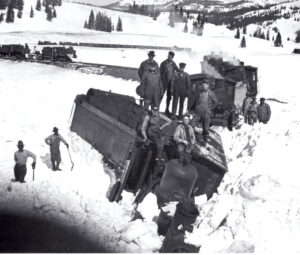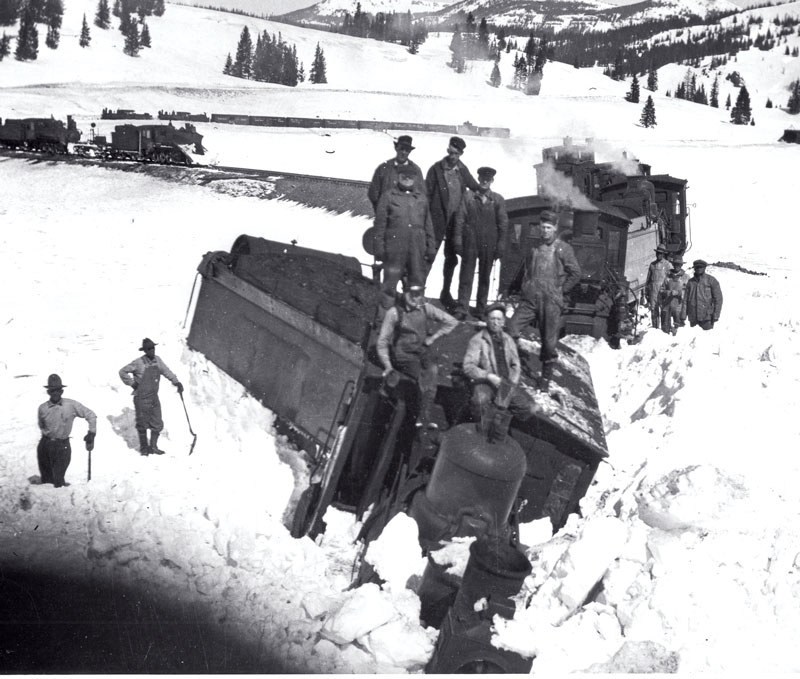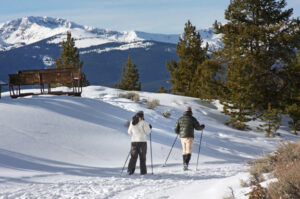By Virginia McConnell Simmons
Trains had first reached Durango in 1881, and the railroad was learning quickly that the difficulties of operating the San Juan Extension across the mountains between Alamosa and Durango happened so often that the word wreck was taboo. There were snow slides, rock slides, washouts and derailments, and winter weather was a special enemy on Cumbres Pass (el.10,022 feet), where wind could deliver snow that drifted 30 or more feet deep. Remember, there were no rotary plows in those early years – only shovels wielded by cold, weary crews.
Youngsters and oldsters know the story about “The Little Engine That Could,” but when snow fell deep and winds blew hard, the white stuff overwhelmed trains that could not move, no matter how much they huffed and puffed. The locomotives lacked sufficient size and motive power to win contests with deep drifts, to say nothing of the grades and tight curves like those on Cumbres Pass. To imagine what a miniature Denver & Rio Grande narrow-gauge locomotive was up against in 1884 when the following event took place, picture a steam engine even smaller than the type that today carries merry tourists each summer over Cumbres Pass.

Eight men and eight women were the passengers on the westbound San Juan Express to Durango when No. 3 pulled out of Alamosa on January 6, 1884, around 8:30 a.m., if the departure was actually on schedule that day. Possibly the passengers had come in during the night from Denver on the sleeper after some big event in the city and were expecting to sleep in their own beds in Durango that night. Based on information from old timetables, a freight would have departed about an hour before the passenger train and would be running ahead until both reached Bighorn, where No. 3 would pass the freight. No. 3 then would be running ahead through Toltec, Osier, and Los Pinos toward Cumbres Pass while snow fell and deepened until the freight gave up. No. 3 was now alone in the worsening storm.
No. 3 forged onward until it struck a drift at Tanglefoot Curve, where it stuck fast, unable to move forward or to back out, only about a mile from the top of the pass. I have tried to identify the spot and believe it might have been at the lower curve of Tanglefoot, where another epic battle occurred in the early 1950s.
Up in the cab of No. 3, the engineer tweeted the little whistle from time to time, but in the roaring storm no one at the summit a mile away could hear it. The telegraph line was down, so no one knew that the train still might be expected to appear, and nothing was moving up the west side either. The passengers, who probably were accustomed to surviving in the Old West without whining, waited. The train’s conductor, whose wife had been critically ill when he left Alamosa, tried to conceal his own worries. And time ticked by, while the wind howled and the drifts deepened.
By the third day in the drift, a trainman struggled through the snow up to the pass and informed the surprised crew at the station and section house, “Cumbreez, we have a problem,” to paraphrase an astronaut. He and others returned with a sled loaded with food and supplies, writes veteran railroader John B. Norwood in his classic book, “Rio Grande Narrow Gauge.” In the ensuing days, the men dug a tunnel between the train and the depot to make communication and travel back and forth a fraction easier. Some cut firewood to keep the cars warm and to melt the overly abundant supply of snow for cooking and washing. Passengers in those days their brought their own lunch and snacks, enough for a one-day trip on the San Juan Extension, but soon rationing became necessary to feed both those marooned on the train and those up on the pass, although the latter had a side of beef to share. Given the option of bunking in the section house with the crew, those on the train chose to stay in their now-familiar haven on the train, while snow continued to fall.
Norwood does not report how long the siege lasted for the passengers, but one account says it was for two weeks. Eventually, a train from Chama made it up the west side’s Windy Point, and next came the struggle to get all the passengers up to the pass, with skis for some and sleds for others, undoubtedly looking considerably the worse for wear, to board a rescue train and continue their journey at last. The conductor of No. 3 turned over his responsibility for the train to the engineer and made it down to Alamosa, where he would learn that his wife, sadly, had died during his absence.
In April the “Little Engine That Could Not” finally was dug from its frigid tomb, and the San Juan Extension reopened at last, allowing the little Denver & Rio Grande trains to huff and puff again over Cumbres Pass, until the next disaster.
The author has enjoyed at least a dozen trips on the Cumbres & Toltec without mishap.



